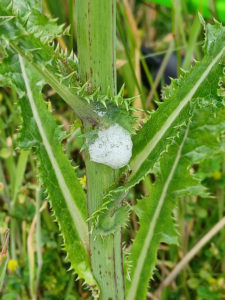This time of year it’s not unusual to be walking through a garden or meadow and suddenly come across what looks like a wad of spit or foam stuck to the stem of a plant. This wasn’t left by some uncouth person, nor is it the remnants of some pesticide or other chemical. Instead, it’s the active shelter of a spittlebug!
What is a Spittlebug, Exactly?
 As the name suggests, these insects create these foamy conglomerations. They then use them as shelter while they feed on the sap of the host plant. There are literally thousands of species within the superfamily Cercopoidea, consisting of the three families Aphrophoridae, Cercopidae, and Clastopteridae. They’re also colloquially known as froghoppers, though the nymph stage that is found within the spit doesn’t yet hop.
As the name suggests, these insects create these foamy conglomerations. They then use them as shelter while they feed on the sap of the host plant. There are literally thousands of species within the superfamily Cercopoidea, consisting of the three families Aphrophoridae, Cercopidae, and Clastopteridae. They’re also colloquially known as froghoppers, though the nymph stage that is found within the spit doesn’t yet hop.
The spit protects the nymphs in a few ways. It’s a visual cover to keep predators from seeing them. If a predator should try to eat the spit, nymph and all, it will find that the foam has a rather awful taste. And it can offer some protection from heat and sunlight on hot summer days. It’s made of waste material from digested sap; one nymph can cycle three hundred times its body weight in sap through its system in one hour.
While sap isn’t exactly a calorie-dense food, spittlebug nymphs have secret allies that were only recently discovered. It turns out that they have not one but two species of bacteria living in their digestive systems. In a symbiotic relationship, the bacteria take shelter there while helping the spittlebug acquire extra nutrition. How? By turning glucose from the sap into crucial amino acids that the nymph needs. Other insects that survive on sap also have these sorts of bacteria, but only one species each rather than two.
Adult spittlebugs are also pretty remarkable. They’re even better jumpers than fleas considering their larger size. Some still retain aposematic coloration that warns away predators. And while they may only live a few weeks after molting into their adult form, the females of some species can lay several dozen eggs before she dies.
Do I Need to Remove Spittlebugs?
Here’s the thing: the vast majority of spittlebugs aren’t going to seriously harm your plants. They don’t take enough sap, and aren’t going to hide in their foamy homes long enough to be a concern. If you have a LOT of them on one plant, they may cause a bit of distortion of the plant’s tissues, temporarily weaken its immune system or open it to diseases through the wounds, but this is a rare situation. And the spittlebug species that don’t produce bad-tasting secretions are potential food for other animals, so they do have an ecological role to play.
 Occasionally species like the meadow spittlebug (Philaenus spumarius) may carry the bacteria Xylella fastidiosa which can cause widespread diseases in agricultural crops like Pierce’s disease or olive quick decline syndrome. But the plants in your garden are not likely to suffer the same fate, especially if you’re growing a nice variety of species rather than an entire plantation of one thing.
Occasionally species like the meadow spittlebug (Philaenus spumarius) may carry the bacteria Xylella fastidiosa which can cause widespread diseases in agricultural crops like Pierce’s disease or olive quick decline syndrome. But the plants in your garden are not likely to suffer the same fate, especially if you’re growing a nice variety of species rather than an entire plantation of one thing.
Finally, I want to advocate for biodiversity rather than the kneejerk reaction “It’s a bug on my plant–kill it!”. You want bugs in your garden (especially native species), because that means it’s an active ecosystem that supports local life. If you determine that you have a non-native species like the aforementioned meadow spittlebug, then all you need to do to get rid of it is hose down the affected plants as needed; pesticides won’t penetrate through the spit anyway, and a hose is faster, cheaper, and safer. Otherwise, native species of spittlebug are not going to cause you any issues, will be gone in a few weeks, and have a place in their ecosystem, too. So enjoy the fact that you’ve created a good home for wildlife, and marvel at these insects with a rather unique strategy for survival!
